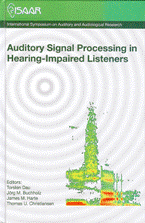Learning volume control for hearing aids
Abstract
A Learning Volume Control (LVC) for hearing aids has been developed, tested and introduced in the market. It has the look and feel of a normal VC, the extra feature is that it gradually learns a more optimal VC setting during regular use of the hearing aid. It does so by combining features of the current input sound with past user behavior (past VC operation stored in the aid’s memory). The aimed effect is that users, over time, will need less VC adjustments when being exposed to changing acoustical environments. Like a normal VC, the LVC will always and instantly change the volume when operated, so the user will stay in immediate control of volume at all times, thus always being able to cope with wanted exceptions to the learned pattern. Our LVC concept has been tested in a number of patient trials (Chicago, Copenhagen, and Oldenburg) with very comparable results. Aver- age learning amounted to 2.4 dB from the default, with very large individual differences. We also found a large variability in learned volume, per patient, over different environments. This clearly shows the benefit of environmental steering in the personalization of volume. We conclude that automatic adaptation of volume by a learning algorithm is well appreciated by users, both with respect to environmental steering and personalization.
References
Dijkstra, T. M. H., Ypma, A., de Vries, B., and Leenen, J. R. G. M (2007). “The Bayesian Approach to Hearing Aid Fitting: An Example with Common Sense Reasoning,” The Hearing Review, Oct 2007.
Dillon, H., Zakis, J. A., McDermott, H., Keidser, G., Dreschler, W, Convery, E. (2006). “The trainable hearing aid: What will it do for clients and clinicians?,” Hear Jour. 59(4) 31-36.
Hamacher, V., Chalupper, J., Eggers, J., Fischer, E., Kornagel, U., Puder, H., and Rass, U. (2005). “Signal Processing in High-End Hearing Aids: State of the Art, Challenges, and Future Trends,” EURASIP Journal on Applied Signal Processing 18, 2915–2929.
Ypma, A., de Vries, B., and Geurts, J. (2006-1). “Robust Volume Control Personalisation From On-Line Preference Feedback,” IEEE Int. Workshop on Machine Learning for Signal Processing, Maynooth, Ireland, 2006.
Ypma, A., de Vries, B., and Geurts, J. (2006-2). “A learning volume control that is robust to user inconsistency,” The second annual IEEE Benelux/DSP Valley Signal Processing Symposium, Antwerp, March 2006.
Additional Files
Published
How to Cite
Issue
Section
License
Authors who publish with this journal agree to the following terms:
a. Authors retain copyright* and grant the journal right of first publication with the work simultaneously licensed under a Creative Commons Attribution License that allows others to share the work with an acknowledgement of the work's authorship and initial publication in this journal.
b. Authors are able to enter into separate, additional contractual arrangements for the non-exclusive distribution of the journal's published version of the work (e.g., post it to an institutional repository or publish it in a book), with an acknowledgement of its initial publication in this journal.
c. Authors are permitted and encouraged to post their work online (e.g., in institutional repositories or on their website) prior to and during the submission process, as it can lead to productive exchanges, as well as earlier and greater citation of published work (See The Effect of Open Access).
*From the 2017 issue onward. The Danavox Jubilee Foundation owns the copyright of all articles published in the 1969-2015 issues. However, authors are still allowed to share the work with an acknowledgement of the work's authorship and initial publication in this journal.


